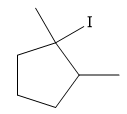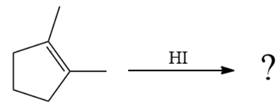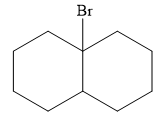
(a)
Interpretation:
For the given reaction, a complete, detailed mechanism is to be drawn, and the major product, ignoring stereochemistry, is to be predicted.
Concept introduction:
An electrophilic addition reaction is an addition reaction where a
Answer to Problem 11.1P
The complete mechanism for the given reaction is

The major product of the reaction is

Explanation of Solution
The given reaction is
![]()
The given reaction occurs in two steps. The electrophilic addition is the first elementary step. The

The product of an electrophilic addition reaction is formed as a result of the addition of the two parts of a Bronsted acid across a double bond, replacing one
(b)
Interpretation:
For the given reaction, the complete, detailed mechanism is to be drawn, and the major product is to be predicted.
Concept introduction:
An electrophilic addition reaction is an addition reaction where a
Answer to Problem 11.1P
The complete mechanism of the given reaction is

The major product of the reaction is

Explanation of Solution
The given reaction is

The given reaction occurs in two steps. The first elementary step is an electrophilic addition, where the

The product of an electrophilic addition reaction is formed as a result of the addition of the two parts of a Bronsted acid across a double bond, replacing one
(c)
Interpretation:
For the given reaction, the complete, detailed mechanism is to be drawn, and the major product is to be predicted.
Concept introduction:
An electrophilic addition reaction is an addition reaction where a
Answer to Problem 11.1P
The complete mechanism of the given addition reaction is

The major product of the reaction is

Explanation of Solution
The given addition reaction is

The given reaction occurs in two steps. The electrophilic addition is the first elementary step. The

The product of an electrophilic addition reaction is formed as a result of the addition of the two parts of a Bronsted acid across a double bond, replacing one
(d)
Interpretation:
For the given reaction, the complete, detailed mechanism is to be drawn, and the major product is to be predicted.
Concept introduction:
An electrophilic addition reaction is an addition reaction where a
Answer to Problem 11.1P
The complete mechanism of the given addition reaction is

The major product of the reaction is

Explanation of Solution
The given addition reaction is

The given reaction occurs in two steps. The electrophilic addition is the first elementary step. The

The product of an electrophilic addition reaction is formed as a result of the addition of the two parts of a Bronsted acid across a double bond, replacing one
Want to see more full solutions like this?
Chapter 11 Solutions
ORGANIC CHEMISTRY E-BOOK W/SMARTWORK5
- Draw the complete, detailed mechanism and the products for each of the following reactions.arrow_forwardPredict the major product of each of the following reactions and provide the complete, detailed mechanismarrow_forwardDraw the complete, detailed mechanism for the following reaction.arrow_forward
- Draw a complete, detailed mechanism for this reaction.arrow_forwardPredict the major products of the following reactions. Draw the complete, detailed mechanism that leads to the formation of each of those products.arrow_forwardDraw a detailed mechanism of the following reactions and determine the major product:arrow_forward
- Draw a complete, detailed mechanism for the following reaction. A key intermediate is provided.arrow_forwardDraw a complete, detailed mechanism AND predict the major organic product for the following transformations a, b & c.arrow_forward(SYN) Show how to synthesize the following molecule from any compounds containing two carbons. Draw the complete, detailed mechanism for the reaction.arrow_forward
 ChemistryChemistryISBN:9781305957404Author:Steven S. Zumdahl, Susan A. Zumdahl, Donald J. DeCostePublisher:Cengage Learning
ChemistryChemistryISBN:9781305957404Author:Steven S. Zumdahl, Susan A. Zumdahl, Donald J. DeCostePublisher:Cengage Learning ChemistryChemistryISBN:9781259911156Author:Raymond Chang Dr., Jason Overby ProfessorPublisher:McGraw-Hill Education
ChemistryChemistryISBN:9781259911156Author:Raymond Chang Dr., Jason Overby ProfessorPublisher:McGraw-Hill Education Principles of Instrumental AnalysisChemistryISBN:9781305577213Author:Douglas A. Skoog, F. James Holler, Stanley R. CrouchPublisher:Cengage Learning
Principles of Instrumental AnalysisChemistryISBN:9781305577213Author:Douglas A. Skoog, F. James Holler, Stanley R. CrouchPublisher:Cengage Learning Organic ChemistryChemistryISBN:9780078021558Author:Janice Gorzynski Smith Dr.Publisher:McGraw-Hill Education
Organic ChemistryChemistryISBN:9780078021558Author:Janice Gorzynski Smith Dr.Publisher:McGraw-Hill Education Chemistry: Principles and ReactionsChemistryISBN:9781305079373Author:William L. Masterton, Cecile N. HurleyPublisher:Cengage Learning
Chemistry: Principles and ReactionsChemistryISBN:9781305079373Author:William L. Masterton, Cecile N. HurleyPublisher:Cengage Learning Elementary Principles of Chemical Processes, Bind...ChemistryISBN:9781118431221Author:Richard M. Felder, Ronald W. Rousseau, Lisa G. BullardPublisher:WILEY
Elementary Principles of Chemical Processes, Bind...ChemistryISBN:9781118431221Author:Richard M. Felder, Ronald W. Rousseau, Lisa G. BullardPublisher:WILEY





